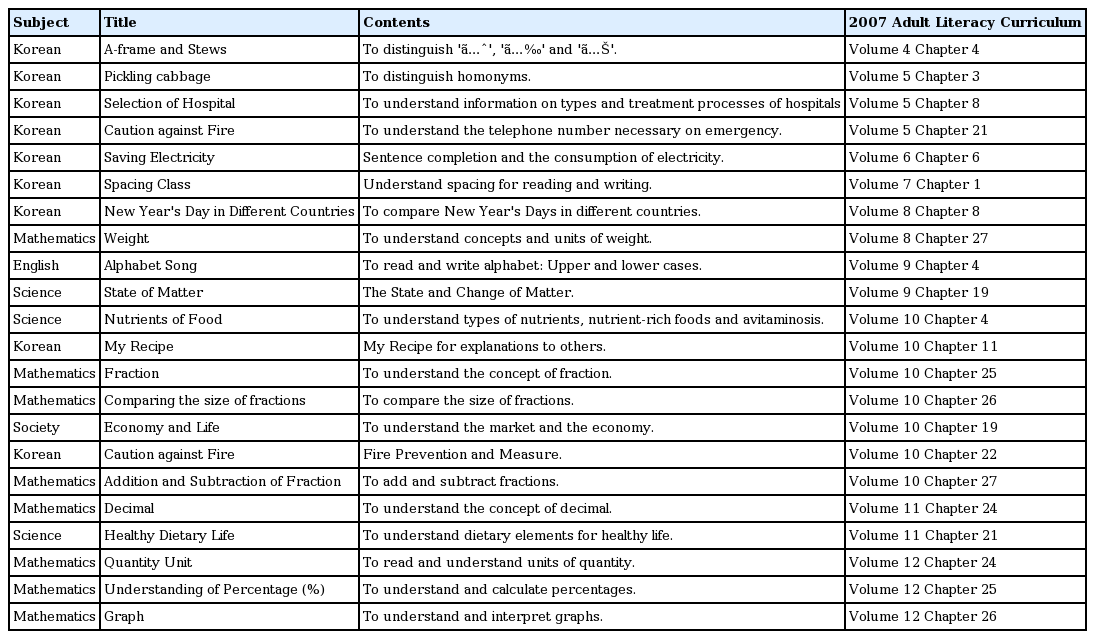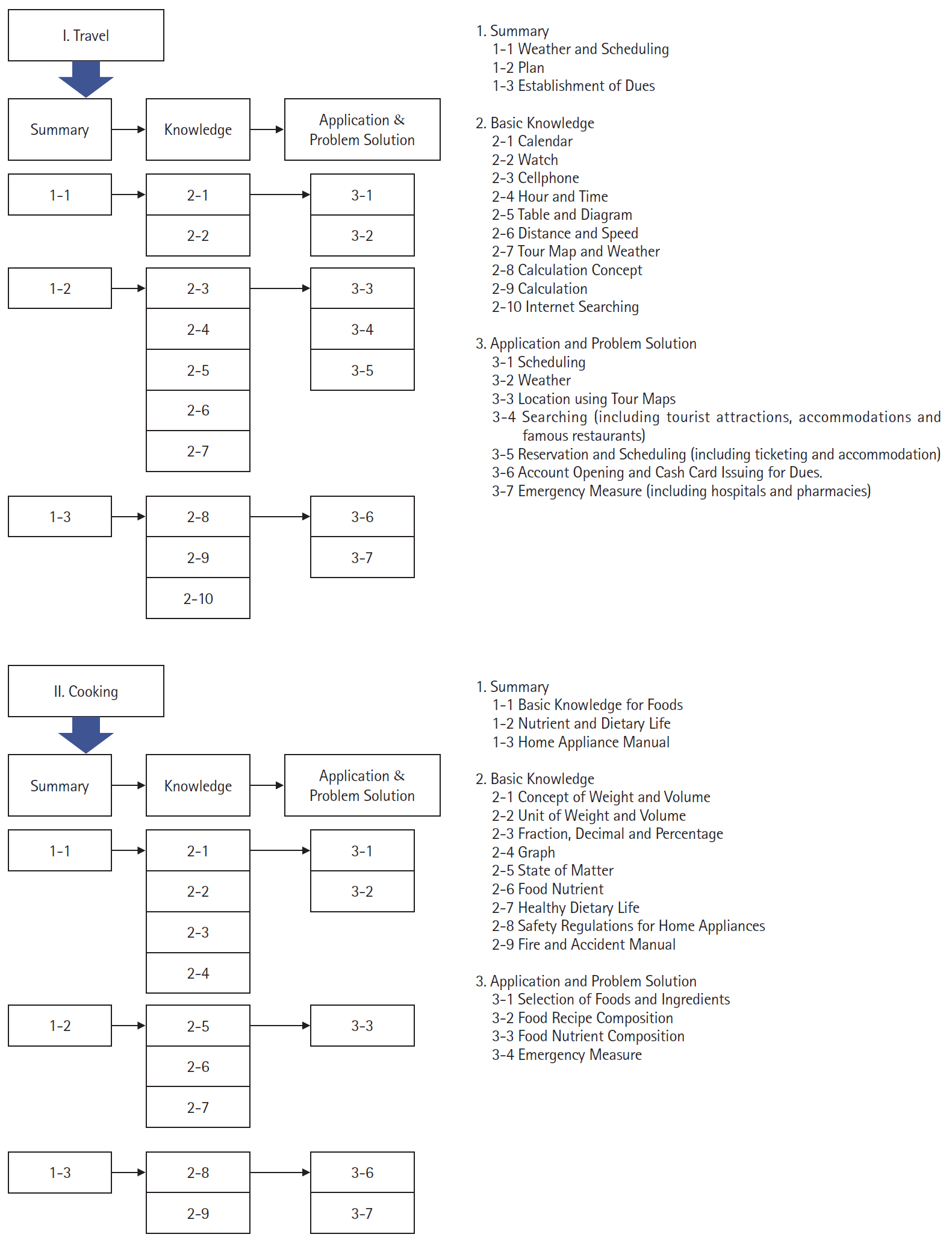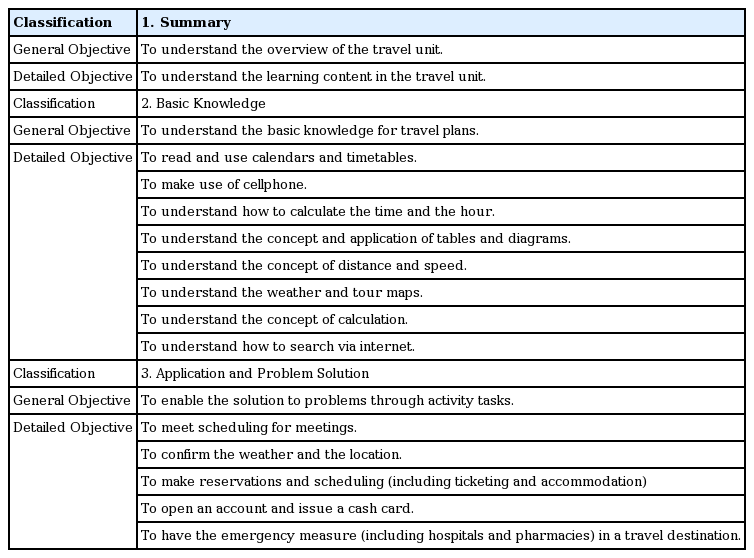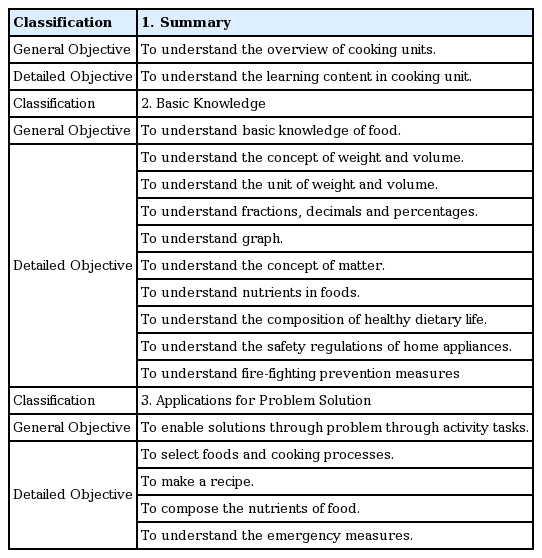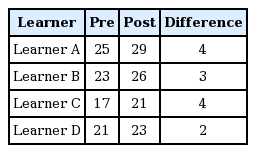Development and Application of an Integrated Curriculum Centered on Mathematics for Elderly Generations
Article information
Abstract
Purpose
To develop an education program based on adult learning principles and actual experiences of elderly generations to develop an integrated curriculum centered on Mathematics.
Methods
Using a theme-based integrated curriculum design for a particular group of elderly learners (n=4x18), this study followed a sequence in program development: Assessing the needs, choosing a theme, studying a topic, writing a rationale, brainstorming, stating the learning objective, planning the project, establishing detailed activity plans, programming the learning time, and assessing the efficiency and the validity.
Results
Using our data analysis, core concepts were applied to everyday experiences of travel and cooking; the need to develop numeracy for elderly generations informed the development of unit objectives and learning outcomes within a Korean adult literacy curriculum. Implementation of the curriculum led to some improvement as evident from the pre- and post-results using the K-mmse; it was also possible for the elderly generations to engage in cooperative learning events and complement each other during the problem solving processes.
Conclusion
This study is significant in that it develops and applies the principles of Problem-based Learning (PBL) - an integrated curriculum design, use of real-life topics and consideration of the needs of the learner, in this case, elderly generations. As a learner-centered curriculum, it gave greater motivation to learners and made the mathematics subject relevant to their needs. It is necessary to consider the diversity across generations of learners and develop curricula in accordance with their needs.
INTRODUCTION
‘Integration’ implies ‘the connection of things for the whole’, or ‘qualitative change to combine components into a new whole’ (Myeoung, 2002). Over two decades ago the seventh curriculum for secondary education reestablished the concept of an integrated curriculum encouraging its management using activity-based topics rather than attempting integration across subjects (The Ministry of Education, 1997). However, integration is not evident within the environment of adult education in Korea. The National Institute for Lifelong Education was established as a part of aspirations for an approach to lifelong education or ongoing learning. Nevertheless, approaches to Korean education have not realized any principles for curriculum development for mature adults, although there are some positive developments.
Resources for elderly generations now center on ‘The Adult Literacy Text (The National Institute for Lifelong Education, 2012)' emerging from a national project; the 2019 Adult Literacy Text will be soon published as a revised edition. Trial and error was a feature of the early stages of curriculum development suited to the principles of adult learning but curricula for the elderly generations of learners have made their mark through two development processes. Thus, our study on the development and application of an integrated curriculum is designed for elementary and secondary courses of adult literacy, providing suggestions for the methodology of curriculum development. The elementary course within these curricula focuses on adult literacy; when embedded within a secondary course, the same principles can be realized within a subject. The characteristics of this adult literacy curriculum for elderly generations in Korea are based on learning events reflecting everyday experiences of members of the elderly learners. The mathematical concepts underpinning the development of numeracy, should be considered a priority.
Curriculum design featuring the experiences of an elderly generations, and those of adults, overlap within a range of subject-based curricula; the overlap becomes intensified within topics and the incremental development of mathematical concepts. Some formal subjects can be seen as meaningless and time-wasting for the elderly. The ultimate goal for elderly learners is to improve their quality of life.
The learning needs of elderly generations are important as changes in society, especially around technologies, impact their lives. Elderly generations have led their lives independently. Their quality of life has become a hot issue in our society. Thus, we suggest the use of more learner-centered integrated curricula based on real life situations, reflecting everyday experiences. This integrated curriculum centered on mathematics emphasizes learning processes reflecting intuitive thinking, the development of cooperative teaching and learning among seniors to promote positive attitudes and integration of relevant information and knowledge in modern society.
Consideration of the hierarchical map of mathematical concepts was central to the education programs based on other real-life experiences of elderly learners. This study was designed to describe the outcomes of an integrated approach to development and application of relevant concepts centered on mathematics for elderly generations and how it applies in daily practice.
THEORETICAL BACKGROUND
1. Theme-based Integrated Education
‘The Integrated Approach’ has developed as a part of progressive education; it has been actively studied in Korea since 1990 (Kim, 2000). As early as 1979, Ingram reported that an integrated curriculum is significant for the following reasons that remain today.
First, learners can cultivate the ability to handle the extensive knowledge and information, that has increased these days. The main ideas and basic principles underpinning integration are drawn from and reflected in a wide range of studies. Also, ideas from different realms of knowledge are linked in an organized way, promoting their relevance, accessibility, penetration and wholeness.
Second, the integrated approach makes learners follow their own learning process. The reflective thinking of Dewey (1933) and the discovery learning of Bruner (1961) emphasizes the learning process itself, asserting inquiry-based activities with topics rather than the acquisition of factual information. So, it can achieve a sense of balance within an individual as well as between the individual and the environment, developing evenly the cognitive and affective areas at the same time.
Third, integrated approaches have the function of learning how to cope with social problems. To solve various problems occurring in modern society, it is necessary that one should have the integrated knowledge applicable to many fields, not just knowledge of a specific field. In other words, the learning and the life experiences should not be isolated from Third, integrated approaches have the function of learning how to cope with social problems. To solve various problems occurring in modern society, it is necessary that one should have the integrated knowledge applicable to many fields, not just knowledge of a specific field. In other words, the learning and the life experiences should not be isolated from each other; school education for example should apply to everyday life.
Therefore, integrated educational content and processes are designed to link a lot of ideas systematically, helping with problem solving, organizing them in accordance with the development of learners, promoting their holistic growth, increasing cooperation among peers and thus maximizing the learning effect based on the interaction among the elements.
2. Integrated Curriculum Centered on Mathematics for Elderly generations
Research relevant to this study centered on mathematics education for elderly generations suggests it has application as follows: analysis of interactions between seniors in speed calculation, mathematics for development of thinking and gaming skills (Seo, 2007), approaches to development of programs to investigate mathematical characteristics relevant to the elderly in terms of cognitive and other affective areas (Lee, 2007;Joo, 2007;Lee, 2008) and analysis of ‘calculation characteristics’ in seniors (Choi, 2008).
Although few programs have been based on research, these are mainly composed of real-life topics and calculations. A mathematics literacy program was recently developed based on the experiences of elderly generations with mathematics education (Lee & Ko, 2018). The experiences of elderly generations should have a central place in education considering their cognitive and affective needs.
3. Literacy Educational Processes for Adults
The necessity for literacy educational processes for adults has been raised as an essential foundation to establish systems to certify qualifications, to provide literacy education for adults, to increase demand for learning materials, and to develop independent processes of education. The latter, suitable for adult learners, are differentiated from those for juvenile learners, especially in the field of literacy education. Thus, emerging from a focus on queries about demands for educational sites for literacy education for adults, consideration of the needs of professionals, developing textbooks for such education, thoughts of researchers, and advice from professionals working at their actual worksites, an essential system and content within a textbook was finalized (The National Institute for Lifelong Education, 2012).
The components for national literacy education for adults include suggestions for each step.
4. Real-life Topic Selection
In the Development Model of theme-based Integrated curricula (Frazee & Rudnitski, 1995) the assessment process was as follows; ① Assessing Needs → ② Choosing a Theme in the Organization of Curriculum → ③ Selecting a Studying Topic for Each Subject → ④ Writing a Rationale for the Selected Topic and Concept → ⑤ Brainstorming → ⑥ Making a Statement for the Learning Objective → ⑦ Designing the Project → ⑧ Establishing the Detailed Activity Plan → ⑨ Planning the Learning Time → ⑩ Considering the Efficiency and Validity of Integrated Curriculum.
Our needs analysis suggested a program design to reflect cognitive and affective characteristics of elderly generations who might have graduated a long time ago or did not attend school at all. We tried to reflect excitement around their needs to learn mathematical concepts, as they thought these difficult to study and apply in many real-life situations. Their goal to learn about mathematical ideas was located around improvement in their quality of life. We selected life-based materials, that elderly generations are highly likely to develop an interest in and absorb because they are based on their experiences; we then applied these to concepts from the relevant mathematical text.
METHODS
Table 1 outlines the approach taken.
First, we investigated and then integrated the theories from the relevant literature to develop real-life education programs centered on mathematics using a ‘theme-based integration’ approach.
Second, we selected the developmental stages of theme-based education program based on the evidence from research before program development progressed.
Third, we considered the content validity of the education programs which we developed, with two onsite specialists and one educationalist; we then modified our plan according to feedback.
Fourth, we carried out the field study to search demonstrate effectiveness in application and demonstrate the worthiness of the chosen curriculum approach. The field study was carried out 18 times on a group of four elderly learners in the lifelong learning school located in Suwon, Korea.
RESULTS
1. The development of an integration curricula centered on Mathematics for Elderly generations
A. a) Selection of Educational Objectives and b) Learning Content
a) This study is designed as the developmental research of curriculum for elderly generation learners, comprehensively forming the real-life topics in the mathematics subject to improve the quality of life for learners.
b) the learning content used to develop centered on mathematics real-life curriculum is shown in Table 2.
B. The Content of 2007 Adult Literacy Education Course by Topic
The content of education programs, related to travel and cooking, are classified by subject, the relationship between them and those of 2007 Adult Literacy Curriculum.
Curriculum content was shown in Table. 2. The 2007 Adult Literacy Curriculum consists of Wish Tree (Volume1~Volume4), Learning Tree (Volume5~Volume8) and Wisdom Tree (Volume9~Volume12) by stages; however, we are presenting only Volumes 1 ~ 12’ for convenience in this study.
a) The Topic of ‘Travel’
The education program topic ‘Travel’, relates to ‘Korean, Mathematics, and Society’ in the 2007 Adult Literacy Curriculum, the major resource used. Specifically, the mathematics is based calculations, while the Korean and Society are related to their real life experiences; details are as follows in Table 3.
b) The Topic ‘Cooking’
The topic cooking also relates to relevant material within the Learning Resources contained in other units: Korean, Mathematics, English, Science and Society in the 2007 Adult Literacy Curriculum. Details are presented in Table 4.
C. Systematization of Learning contents
Subcategories for learning content were grouped and systematized; then, those concepts in each group were integrated through comprehensive integration processes to organize units. These are presented in the following flowcharts.
a) Integration of learning content in Figure 1.
b) The Composition of Units and Establishment of Education Objectives in Table 5.
The following flowchart elaborates on how the we established the composition of learning content for the travel unit and the establishment of education objective based on the comprehensive integration processes.
The composition of learning content for cooking unit and the establishment of education objective based on the comprehensive integration in Table 6.
2. The Assessment of an Integrated Curriculum centered on Mathematics for Elderly generations
A. The Expert Assessment of Content Validity.
The experts’ assessment process was designed to see that the content and level of theme-based integration curriculum were developed with consideration of the learners as follows: According to the opinion of experts, the program provides content which meets the education objectives, to apply in the field study for elderly learners, and thus achieves its development purpose. In particular, they said that it includes those highly accessible concepts underpinning the interests of learners. However, they pointed out that elderly learners spend a lot of time fully understanding in-depth areas of study. Also, there were some opinions expressed that around the question of program design that leads to personal problem solving i.e. self-direction in learning. They suggested that learners might need the guidance of their instructors during the course e.g. using a computer.
Based on the results of above expert assessment, we modified units after considering each piece of feedback. This newly developed program was modified again through many preliminary course implementation processes.
B. The Field Study
When the proposed program was applied in actual classes, elderly learners became highly interested unlike the case where they originally learned about subjects centered on mathematics. Also, these learners reported that they could recognize the need for mathematics given their participation in the program; learners expressed opinions that the program was valuable, as it allowed them to use a calculator on complicated mathematical problems. However, some respondents said they were not confident with mathematics i.e. when using a computer or learning the difficult terms for ingredients during the cooking unit.
As a result of field study feedback, we adjusted the difficulty of computer skills learning activities.
C. Application of Curricula for Elderly Learners.
We implemented this program with four elderly generation learners 18 times; dividing them into groups of two, they participated into group learning processes twice a week. We used the K-mmse (Korean version of Mini-Mental State Exam) tool (Folstein et al., 1975; Lancu & Olmer, 2006;Oh et al., 2010) before and after the course so that we could detect change. Their results were as follows in Table 7.
The following are records of conversations of learners during the course; these show how they solved their problems. In the following situation, Learners A and B were paired to interpret the graph during the travel unit; they were expected to identify from the graph, the second preferences for the site where travelers wanted to go. This question is designed to find that they can read and interpret the graph. Learner B understood exactly the situation; he correctly answered the Palace Museum. Learner A tried to convince him that the tourist attraction is the place they want. However, Learner B again explained the situation to Learner A, but they could not resolve their differences. So, the teacher intervened to help them find the relevant data.
Learner B: Where is the place, where the members want to go most second, in this graph? this is the Palace Museum.
Learner A: No. maybe this is the tourist attraction.
Learner B: The Palace Museum. Sister, look at here. You should see it (pointing at the question). The tourist attraction is here (Pointing at the neighboring bar graph).
Learner B: Um? The place they want to go to. The palace museum.
Learner A: So, they took a bath in the place where they wanted to go most second, and they may hope to go to the tourist attraction.
Learner B: Hey, I already selected the palace (museum) as the second place?
Learner A: I think it is for the tourist attraction? This is the second most visited place...
Teacher: Please consider the height of each bar graph. Can it be counted using this table?
Learner A: (Pointing at the graph by the finger) Here? here? the second most... ah... it is the museum.
In the following case Learners C and D were paired to interpret the graph during the cooking unit. The question was about the ratio of each ingredient (including fat and protein) in the pie graph. Learner D understood the nutrient was carbohydrate, accounting for 68 percent in the pie graph. Learner C understood that protein accounted for 9 percent. The following conversation shows how they discussed the question, encouraging each other.
Learner C: um... others... (read again more carefully for a while) Other fats, protein, water. So, others, fats, protein and water are 2 percent, 3 percent, 9 percent and 18 percent, respectively. Isn’t the total 100?
Learner D: Yes, you’re right. Haven’t you learned pro (the abbreviation of percentage) carbohydrate accounts for 68 percent.
Learner C: Carbohydrate accounts for 68 percent. So, you mean that all should add up. I learnt gram (g) as well.
Learner C: 68%. Write the most ratio here. Read... (read the question carefully) ‘Write the most ingredient in this food.’ So, we write ‘carbohydrate’ here.
Learner C: Do I write 68 only?
Learner D: You should write pro (percentage) also. (Alas) I haven’t known these until now.
Learner C: It’s not too late. I do this thing! (Laugh)
CONCLUSIONS AND RECOMMENDATIONS
This study was designed to develop an integrated curriculum centered on mathematics for elderly generations, using real-life topics based on the experiences of the elderly learners. We analyzed the content of many different subjects in Korean adult literacy curricula to develop an integrated curriculum. Tests for content validity were undertaken by three experts including two onsite specialists and one subject-educationalist. Curricula were modified immediately using the evaluation of learners. Learners were reported to intuitively understand the mathematical concepts, including their real-life elements used as topics; clearly, motivation enhanced the understanding of mathematical concepts.
It is evident that ongoing education is essential in seniors and members of the elderly generations if improvements in their quality of life is to be achieved. Therefore, the establishment of appreciation of educational content and processes and instructor expertise on the characteristics of learners is important if educational outcomes can be optimized for learners. Consideration of their varied experiences and levels of cognitive and physical functions will also impact management of social situations. Like all learners, the individual needs of those of elderly generations should be central to curriculum design and the development of learning activities.
Acknowledgements
This paper was supported by funding from the Halla Newcastle PBL Education and Research Center. The authors thank Professor Margaret McMillan, The University of Newcastle, for her guidance in preparing this paper for publication.



